Sharp-fruited Rush
Juncus acuminatus
Rush family (Juncaceae)
Juncus acuminatus
Rush family (Juncaceae)
Description:
This perennial rush is 6–30" (15–75 cm.) tall with an erect to
ascending leafy
culm; it sometimes forms tufts of leafy culms. Each culm is medium
green, hairless, terete, and unbranched. While this rush is flowering
or fruiting, each culm has a basal sheath that is usually brown,
vertically veined, and hairless, splitting open at its apex obliquely
with short rounded auricles;
this sheath is sometimes reddish at the base. There are typically about
2 leaf blades along each culm. The lower leaf blade is 6–10" (15–25
cm.) long and 1–2 mm. across; it is medium green, hairless, terete or
subterete (terete but slightly flattened), and either ascending or
arching. The upper leaf blade is 1½–4" (4–10 cm.) long and 0.5–1
mm. across; it is similar to the lower leaf blade, except smaller in
size and more erect.
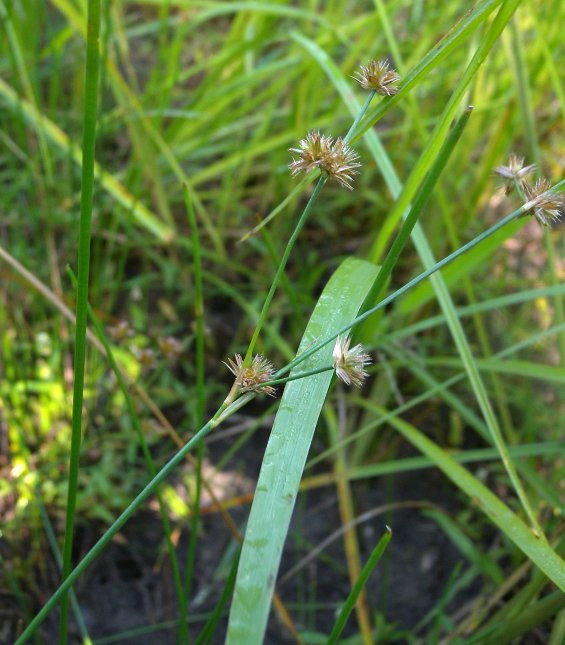
The culm terminates in an irregular panicle of clustered flowers spanning 2½–8" (6–20 cm.) long and 1½–5" (4–13 cm.) across; each panicle typically has 5–20 clusters of flowers (rarely more). The branches of the panicle are usually erect to ascending; they are medium green, hairless, and terete. There are 5–15 flowers per cluster (rarely more), spanning 5–10 mm. across; each floral cluster forms a one-third to two-thirds hemispheric shape. At the base of each floral cluster, there are a few inconspicuous chaffy bracts. Each flower consists of 6 tepals (3 inner tepals and 3 outer tepals), an ovary with a style, and 3 stamens. The scale-like tepals are 2.5–3.5 mm. long and narrowly lanceolate in shape with membranous margins; depending on their maturity, they are brownish green to brown. The blooming period occurs from mid-summer to early autumn, lasting about 2–4 weeks for a colony of plants. The flowers are cross-pollinated by the wind.
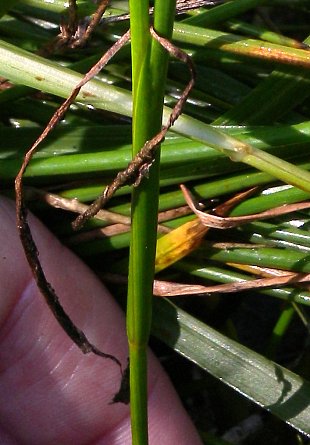
Afterwards, seed capsules develop that are 2.5–3.5 mm. long and ellipsoid in shape with acute tips; tiny beaks at the tips of these capsules are remnant styles. At maturity, the seed capsules are dark brown and about the same length as the tepals. They eventually split open to release tiny seeds; these seeds are small enough to be distributed by the wind or water currents. Individual seeds are about 0.3 mm. long, narrowly ellipsoid, and slightly flattened in shape; they are yellowish brown with fine longitudinal veins. The tips of these seeds may have short beak-like extensions, but they lack slender wings. The root system is fibrous and short-rhizomatous. This rush uncommonly develops clonal plantlets with leaves and roots in its inflorescence, instead of clusters of flowers. These plantlets then drop to the ground, where they can take root.
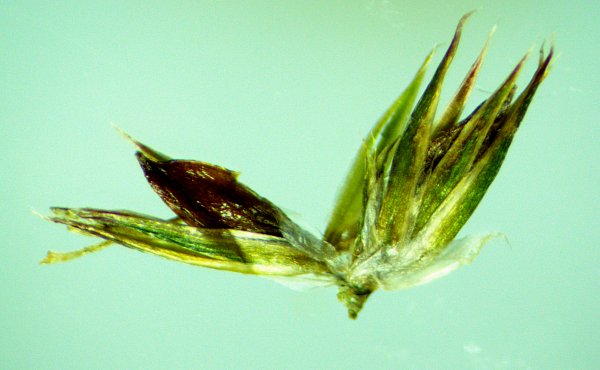
Cultivation: The preference is full to partial sun, wet to moist conditions, and sandy, silty, or mucky soil containing decayed organic matter. Shallow standing water is tolerated if it is seasonal or temporary.
Range & Habitat: Sharp-fruited Rush (Juncus acuminatus) is occasional throughout Illinois, where it is native (see Distribution Map). It is widely distributed in the eastern half of the United States and adjacent areas of Canada; it also occurs along the Pacific coast and widely scattered areas of western United States. Habitats include swamps, edges of marshes (sandy and non-sandy), prairie swales (sandy and non-sandy), gravelly seeps and springs, low areas along ponds and sloughs, wet meadows, and ditches. This rush is found in slightly disturbed to higher quality wetland habitats of various kinds.
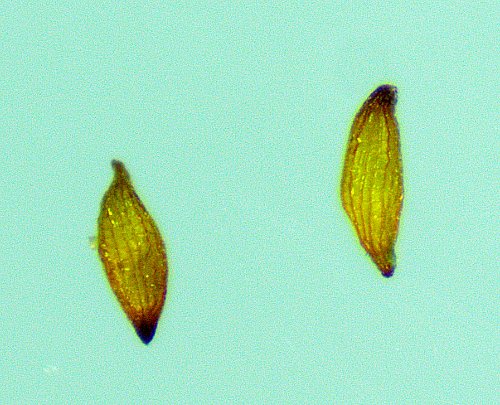
Faunal Associations: Sharp-fruited Rush (Juncus acuminatus) is one of the rushes that the Rush Psyllid (Livia maculipennis) feeds on, deforming the flowers (Osborn, 1905). Other insects that feed on rushes include billbugs, larvae of leaf-miner flies, seed bugs, aphids, leafhoppers, mealybugs, larvae of the Javelin Moth (Bactra verutana) and other moths, grasshoppers, and meadow katydids. For more information, see the Insect Table. Vertebrate animals use rushes only to a limited extent. The Green-winged Teal reportedly feeds on the seeds or seedheads, while the Muskrat feeds on the roots and plant crowns (Anderson, 1959; Hamerstrom & Blake, 1939).
Photographic Location: Edge of a sandy marsh at Bonnie's Prairie Nature Preserve in Iroquois County, Illinois.
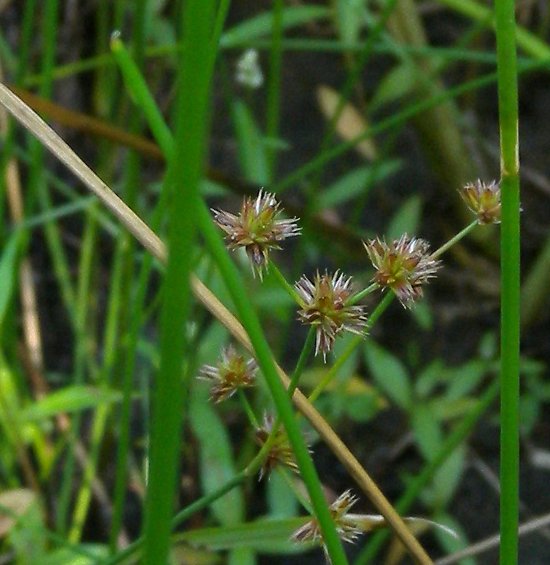
Comments: Other common names of this rather ordinary-looking rush are the Tapertip Rush and Knotty-leaved Rush. Sharp-fruited Rush (Juncus acuminatus) can be distinguished from many other rushes by the relative size of its tepals and seed capsules – they are more or less the same length. In contrast, many rushes (Juncus spp.) have seed capsules that are noticeably longer than their tepals. Another distinguishing characteristic is that both its tepals (narrowly lanceolate) and its seed capsules (ellipsoid in shape) have acute tips. In contrast, the tepals and/or seed capsules of many other rushes have more blunt tips. Sharp-fruited Rush can also be distinguished by the number of flowers per cluster (5-15) in its inflorescence. Some similar rushes, like Jointed Rush (Juncus articulatus), have only 3-5 flowers per cluster, while other rushes have more. It is also helpful to examine the seeds of rushes in order to identify them. Sharp-fruited Rush has very small seeds (even for a rush) that are only 0.3 mm. in length, and they lack the elongated winged extensions at their tips that is a characteristic of some other rushes, like Canada Rush (Juncus canadensis). Sharp-fruited Rush is also one of the rushes that have terete leaf blades (more or less round in cross-section), rather than flattened.

The culm terminates in an irregular panicle of clustered flowers spanning 2½–8" (6–20 cm.) long and 1½–5" (4–13 cm.) across; each panicle typically has 5–20 clusters of flowers (rarely more). The branches of the panicle are usually erect to ascending; they are medium green, hairless, and terete. There are 5–15 flowers per cluster (rarely more), spanning 5–10 mm. across; each floral cluster forms a one-third to two-thirds hemispheric shape. At the base of each floral cluster, there are a few inconspicuous chaffy bracts. Each flower consists of 6 tepals (3 inner tepals and 3 outer tepals), an ovary with a style, and 3 stamens. The scale-like tepals are 2.5–3.5 mm. long and narrowly lanceolate in shape with membranous margins; depending on their maturity, they are brownish green to brown. The blooming period occurs from mid-summer to early autumn, lasting about 2–4 weeks for a colony of plants. The flowers are cross-pollinated by the wind.

Afterwards, seed capsules develop that are 2.5–3.5 mm. long and ellipsoid in shape with acute tips; tiny beaks at the tips of these capsules are remnant styles. At maturity, the seed capsules are dark brown and about the same length as the tepals. They eventually split open to release tiny seeds; these seeds are small enough to be distributed by the wind or water currents. Individual seeds are about 0.3 mm. long, narrowly ellipsoid, and slightly flattened in shape; they are yellowish brown with fine longitudinal veins. The tips of these seeds may have short beak-like extensions, but they lack slender wings. The root system is fibrous and short-rhizomatous. This rush uncommonly develops clonal plantlets with leaves and roots in its inflorescence, instead of clusters of flowers. These plantlets then drop to the ground, where they can take root.

Cultivation: The preference is full to partial sun, wet to moist conditions, and sandy, silty, or mucky soil containing decayed organic matter. Shallow standing water is tolerated if it is seasonal or temporary.
Range & Habitat: Sharp-fruited Rush (Juncus acuminatus) is occasional throughout Illinois, where it is native (see Distribution Map). It is widely distributed in the eastern half of the United States and adjacent areas of Canada; it also occurs along the Pacific coast and widely scattered areas of western United States. Habitats include swamps, edges of marshes (sandy and non-sandy), prairie swales (sandy and non-sandy), gravelly seeps and springs, low areas along ponds and sloughs, wet meadows, and ditches. This rush is found in slightly disturbed to higher quality wetland habitats of various kinds.

Faunal Associations: Sharp-fruited Rush (Juncus acuminatus) is one of the rushes that the Rush Psyllid (Livia maculipennis) feeds on, deforming the flowers (Osborn, 1905). Other insects that feed on rushes include billbugs, larvae of leaf-miner flies, seed bugs, aphids, leafhoppers, mealybugs, larvae of the Javelin Moth (Bactra verutana) and other moths, grasshoppers, and meadow katydids. For more information, see the Insect Table. Vertebrate animals use rushes only to a limited extent. The Green-winged Teal reportedly feeds on the seeds or seedheads, while the Muskrat feeds on the roots and plant crowns (Anderson, 1959; Hamerstrom & Blake, 1939).
Photographic Location: Edge of a sandy marsh at Bonnie's Prairie Nature Preserve in Iroquois County, Illinois.

Comments: Other common names of this rather ordinary-looking rush are the Tapertip Rush and Knotty-leaved Rush. Sharp-fruited Rush (Juncus acuminatus) can be distinguished from many other rushes by the relative size of its tepals and seed capsules – they are more or less the same length. In contrast, many rushes (Juncus spp.) have seed capsules that are noticeably longer than their tepals. Another distinguishing characteristic is that both its tepals (narrowly lanceolate) and its seed capsules (ellipsoid in shape) have acute tips. In contrast, the tepals and/or seed capsules of many other rushes have more blunt tips. Sharp-fruited Rush can also be distinguished by the number of flowers per cluster (5-15) in its inflorescence. Some similar rushes, like Jointed Rush (Juncus articulatus), have only 3-5 flowers per cluster, while other rushes have more. It is also helpful to examine the seeds of rushes in order to identify them. Sharp-fruited Rush has very small seeds (even for a rush) that are only 0.3 mm. in length, and they lack the elongated winged extensions at their tips that is a characteristic of some other rushes, like Canada Rush (Juncus canadensis). Sharp-fruited Rush is also one of the rushes that have terete leaf blades (more or less round in cross-section), rather than flattened.